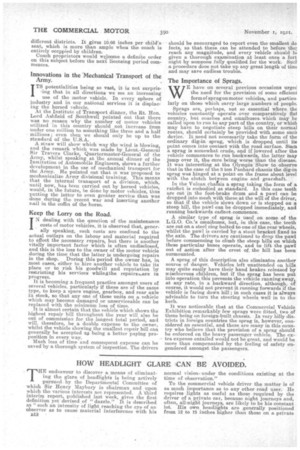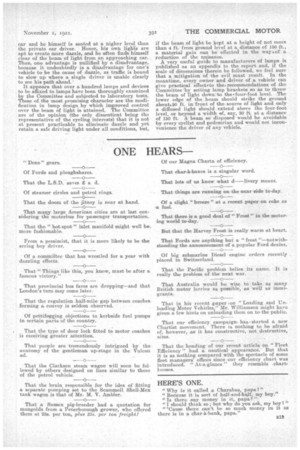HOW HEADLIGHT GLARE , CAN. BE AVOIDED.
Page 2

Page 3

If you've noticed an error in this article please click here to report it so we can fix it.
T HE endeavour to discover a means of eliminating the glare of headlights is being actively pursued by the Departmental Committee of which Sir Henry Maybury is chairman and upon which the various interests are represented. Kthird interim report, published last week, gives the first definition yet devised of "dazzle." It is described as "such an intensity of light reaching the eye of an observer as to cause material interference with his 1312 •
normal vision, under the conditions existing at the time of observation."
To the commercial vehicle driver the matter is of as much importance as to any other road user. He requires lights as useful as those required by the driver of a private car, because night journeys and, often, all-night journeys, are likely to be his constant lot. His own headlights are generally positioned from 12 to 15 inches higher than those on a private car and he himself is seated at a nigher level than the private car driver. Hence, his own lights are apt to create more dazzle,, and he often finds himself clear of the beam of light from an approaching car. • Thus, one advantage is nullified by a disadvantage, because it undoubtedly is a disadvantage for one's vehicle to be the cause of dazzle, as traffic is bound to slow up where a single driver is unable clearly to see his path ahead.
It appears that over a hundred lamps and devices to be affixed to lamps have been thoroughly examined the Committee and subjected to laboratory tests. hose of the most promising character are the modification in lamp design by which improved control over the, beam of light is attained. The Committee are of the opinion (the only dissentient being the representative of the cycling interests) that it is not at present practicable to eliminate dazzle and yet retain a safe driving light under all conditions, but, if the beam of light be kept at a height of not more than 4 ft. from ground level at a distance of 150 ft., a material gain can be effected in the way4of a reduction of the nuisance.
A very useful guide to manufacturers of lamps is published as an appendix to the report and, if the scale of dimensions therein be followed, we feel sure that a mitigation of the evil must result. In the meantime, every owner and driver of a vehicle can give practical effectito the. recommendations of the Committee 'by settin.g lamp 'brackets so as to throw the beam of light down!to thefrfour-foot level. The lower edge of the. beam should strike the ground aboutc50 ft. infront of the•source of light and only a diffused light should extend above the four-foot level, or beyond a width of, say, 30 ft. at a distance of 150 ft. A beam so disposed would be avoidable by every cyclist and pedestrian and, would not inconvenience the driver of any vehicle.
































